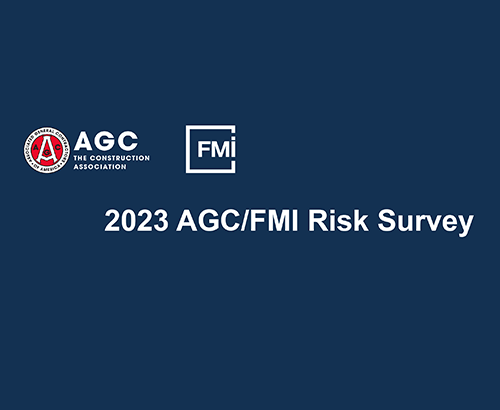In the Path of a Natural Disaster: Lessons Learned for Construction Work Sites

Hurricanes and wildfires in North America have brought new insights to risk management strategies. Can your risk register weather the storm?
If last year’s extreme weather events taught us anything, it’s the need to be prepared for the unpredictable. The devastating wildfires and hurricanes that left a trail of destruction in the U.S. and Canada resulted in staggering losses for people, communities and businesses.
The implications for contractors, whose projects may extend for several years in areas vulnerable to severe weather events, can be daunting. Crafting a robust risk register (a master document created during the early stages of a project to help track issues as they arise) that addresses extreme weather events is vital and can be built upon the tried-and-true practices your company already puts in place.
Hurricanes Harvey, Irma and Maria—all striking in two months’ time—rank among the top-five costliest U.S. hurricanes on record, with an estimated price tag of $265 billion.1 Last year’s California wildfires tallied nearly $12 billion in insured losses,2 and that figure doesn’t include wildfires in other parts of the American West. In Canada, British Columbia wildfires in 2017 destroyed nearly 3 million acres at a cost of $127 million, and the 2016 Fort McMurray wildfire in Alberta proved the costliest in Canadian history at over $3.5 billion.3 4 5
Last year’s experiences and the accumulated wisdom gained over many years can shed light on some key considerations that all E&C firms should be thinking about in 2018.
Planning Is Everything
Avoid complacency
Businesses, like people, often struggle to accept that a severe weather event could affect them, especially when a work site isn’t a direct target of the event. Consider that last year’s hurricanes caused flooding beyond accepted norms and that wildfires can and do occur in every region of the U.S. and Canada. Moreover, their paths are unpredictable. Hurricanes change direction, and wind can blow embers from a wildfire miles away to ignite new fires.
Make your plan specific
Working near an ocean or by fire-prone forests presents two types of hazards that defy a one-size-fits-all plan. Re-evaluate your plan by considering the different exposures for each project. The least-prepared companies are often those that are working in unfamiliar regions. For example, a Midwestern general contractor (GC) hired for a multiyear project in Florida might neglect to consider the necessity of having a hurricane plan. Familiarize yourself with your subcontractors as well. Specificity is critical in crisis management events for any natural disaster.
Protect equipment
When you have an equipment schedule that reaches into the hundreds of millions of dollars, you need a specific plan to protect that investment.
With hurricanes, people often overestimate the wind and underestimate the water. In fact, water is much more of a concern. After Harvey, about 40% of the buildings that the Federal Emergency Management Agency (FEMA) deemed flooded in Harris County, Texas, were not located in flood plains.6
Although you can’t completely remove liability in these situations, you can act to mitigate risk. Some questions to ask:
- Where is the equipment stored?
- Where is your staging area?
- At any one time, how much equipment will be on the staging area, and what is the value of that equipment?
- Are you protecting the equipment as well as you can?
For example, a company had about $50 million worth of equipment staged on a low-lying area near a river that could crest at any time. Indeed, the risk of inland flooding has significantly increased over the past 50 years.7 Made aware of the threat, the company raised the equipment by bringing in gravel to create an area more than three feet above the river.
For wildfires, winds can abruptly shift and/or strengthen, putting a once-safe work site in the fire’s path. Remove all fuel sources from your vehicles and fuel tanks and, where possible, remove the vehicles themselves. Never keep vehicles parked next to structures or combustibles. If you regularly fill tanks and equipment, interrupt that schedule to avoid any potential disasters.
Know where your workers live. Employees with homes in vulnerable areas should not be part of your emergency action or preparedness teams. Also, should an evacuation order arise, determine ahead of time where emergency or preparedness teams will deploy.
Address site vulnerabilities. If your work sites are in an area at risk for wildfires, clear a barrier zone of trees or shrubs that could fuel a fire. Keep these sites as clean as possible; debris can unnecessarily strengthen a wildfire. Moreover, remove anything flammable, which could further accelerate the fire. In hurricane situations, remove objects that could become missiles even in lesser winds than those carried by Category 5 storms.
Know where to set up project trailers. The office of a GC working on a Gulf Coast bayou flooded three times last year due to Harvey, then Irma and then Maria. This might have been mitigated if the GC had thoroughly investigated its trailer site to ensure it wasn’t in a low-lying area. Talk to risk specialists or local authorities, especially if you’re unfamiliar with the region, to explore which areas are and aren’t elevated. The inconvenience and/or expense of a slightly longer drive to your work site may well be worth it. Those sites might also be good places to store your equipment. If you’re building near the ocean, there won’t be as many higher-ground options, so you may want to consider laying down topsoil or gravel to build a place to raise your trailers. You might also be able to put your cranes on these higher areas, which may be enough to save them from substantial damage.
For wildfires, remember that some project offices can be several trailers wide. If trailers are close together, fire could quickly wipe out the entire complex. Spread trailers out and create a firebreak around each trailer (as well as the entire site).
Evacuation: Personal Safety First
The overarching goal of effective evacuation plans is to reduce the time they take to implement. You can do this by taking these steps:
- Map out routes. Do workers know where to go in case of a mandatory evacuation? Consider all evacuation options from the work site. Last year, some people evacuated from Florida to Charlotte, N.C., which wound up having worse weather conditions than where they came from. During fast-moving wildfires, delayed departure times can prove fatal.
- Identify approved evacuation staging areas in your plans. In urban locations, contact local authorities to pinpoint all potential escape routes. In remote Canadian or Pacific Northwest locations, there may only be one road for ingress and egress. Whether the challenge is inching along clogged arteries in populous areas or traveling long distances on a single road, you may want to recommend that all workers have at least half a tank of gas in their vehicles at all times and/or access to extra fuel.
- Plan and time things carefully. Around 36 hours prior to a hurricane, you can mitigate some risk by removing equipment from the shoreline and getting the booms down, but you probably can’t demobilize all of your cranes. At 24 hours, you probably won’t have the trucking ability to do that, especially since everyone will be evacuating from the same location. With wildfires, there may be even less advance warning. In both situations, constantly monitor conditions from local news and government websites. In the event of a power outage, have portable radios or satellite phones available to monitor conditions.
- Anticipate evacuations. The best companies not only have evacuation procedures in place but also regularly conduct unannounced practice drills.
- Save your records. Consider the safety of vital business records. If everything is stored electronically, are you regularly backing up the data, and is it being saved to a main server in a less vulnerable region? On the other side of the coin, are your paper blueprints also in electronic form? Paper documents should be kept in fireproof containers. Evacuation plans should be available in both electronic and paper formats. If your network crashes, you won’t be able to access these crucial documents on a computer when you need them most.
Returning to the Work Site
It’s common for GCs to focus on a severe weather crisis before and during an event, but they often neglect to take steps after the event. When you return to a devastated work site, you will be facing the challenges you had prior to the disaster as well as an unprecedented set of new problems. You can avoid these problems by taking these steps:
- Anticipate post-event hazards. Natural disasters create unique safety challenges. Smoldering debris that can reignite a fire and post-flood waste that can create environmental hazards are just two of many examples. Understand and plan for these risks.
- Secure labor and supplies. Ensure you’ll have what you need, supplywise and laborwise. There may not be as much material available as before because a natural disaster leads thousands of businesses to look for solutions to the same problems. Likewise, finding workers may be difficult. A post-Fort McMurray report from Economic Developers Alberta (EDA) noted that entry-level workers did not return to the region after the wildfire, creating labor challenges.8 Because a natural disaster can create project interruptions lasting several weeks, many workers may be forced to find employment elsewhere. What’s more, the workers who are available may not have the needed experience or knowledge.
Last year, some GCs thought they had done a good job in this phase. But they had secured just one labor service or supply vendor. When the vendor proved unable to deliver following the disaster, it created major challenges. Consider contracts with several vendors.
- Anticipate budget pressures. Because you’ll be competing for supplies and workers with everyone else, costs can rise accordingly. Will your cash flow accommodate this possibility?
- Start small. Once authorized to return to a work site, don’t bring everyone back right away. Instead, deploy a preassigned team to conduct a hazard assessment. Each event creates its own challenges, be it from washouts or downed power lines, as well as the need to perform emergency repairs before a normal project schedule can resume. Internet service may also be limited or absent, creating additional delays.
Nobody knows if 2017’s natural disasters were an aberration or the “new normal,” but they taught us to expect the unexpected. Today’s construction boom is happening in many vulnerable areas. In the U.S., some of the fastest-growing regions are near oceans, and the U.S. Forest Service estimates that wildfire seasons are on average 78 days longer than in 1970 and the number of acres burned each year has doubled since 1980.9 These are today’s realities.
It underscores the importance of a risk register that addresses these profound vulnerabilities and includes a robust risk-mitigation plan that is developed before mobilization. The more you can drill down to the specific location and implications of a natural disaster and get contractors and project teams thinking the same way, the better off you’ll be.
Jennifer Fortunato is a Risk Engineering Manager for the Construction Specialties team at Zurich Services Corporation, where she provides leadership on several lines of business, including Builders Risk CAR/EAR, Construction Property, Subguard® and Professional Liability. Fortunato’s team assists in supporting the development and delivery of the Risk Engineering strategy with an emphasis on risk assessment, risk improvement, claims insights and thought leadership on both a domestic and global level.
Fortunato joined Zurich in 2006 and has held roles including Senior Risk Engineering Consultant and Risk Engineering Manager – Construction Property. She has over 23 years of experience in the construction industry.
Fortunato’s many professional designations include Associate in Risk Management (ARM), Associate in Insurance Services (AIS) and Construction Risk Insurance Specialist (CRIS). She holds a Bachelor of Science degree in building construction management from Michigan State University.
Forrest Ropp has worked for Zurich Services Corporation for over 16 years as a Senior Risk Engineering Consultant specializing in construction loss control. He is a subject matter expert on highway safety, helping large contractors minimize losses and maximize profitability while working along the hurricane-prone Eastern Seaboard of the United States. He was the project manager for Zurich when it collaborated with the Associated General Contractors to produce the multi-asset Highway Worker Safety Program.
Prior to working for Zurich, Ropp worked offshore in the energy field as a geologist and for several large construction companies in safety and project management on heavy civil projects in St. Louis; Denver; Mission Viejo, Calif. and Myrtle Beach, S.C.
He has a Bachelor of Science degree in geology from Southeast Missouri State University, and Associate in Risk Management (ARM) and Construction Risk Insurance Specialist (CRIS) certifications. He is especially proud of his KAMP award (named in honor of four colleagues who lost their lives on 9/11), which is the highest honor given by Zurich North America for philanthropic service.
Disclaimer
The information in this publication was compiled from sources believed to be reliable for informational purposes only. All sample policies and procedures herein should serve as a guideline, which you can use to create your own policies and procedures. We trust that you will customize these samples to reflect your own operations and believe that these samples may serve as a helpful platform for this endeavor. Any and all information contained herein is not intended to constitute advice (particularly not legal advice). Accordingly, persons requiring advice should consult independent advisors when developing programs and policies. We do not guarantee the accuracy of this information or any results and further assume no liability in connection with this publication and sample policies and procedures, including any information, methods or safety suggestions contained herein. We undertake no obligation to publicly update or revise any of this information, whether to reflect new information, future developments, events or circumstances or otherwise. Moreover, Zurich reminds you that this cannot be assumed to contain every acceptable safety and compliance procedure or that additional procedures might not be appropriate under the circumstances. The subject matter of this publication is not tied to any specific insurance product nor will adopting these policies and procedures ensure coverage under any insurance policy.
© 2018 Zurich American Insurance Company. All rights reserved.
1 “Fast Facts: Hurricane Costs.” Office for Coastal Management, National Oceanic and Atmospheric Administration (NOAA). 18 January 2018.
2 “California Statewide Wildfire Insurance Claims Nearly $12 Billion.” California Department of Insurance. 31 January 2018.
3 British Columbia 2017 Wildfire Season Summary. Government of British Columbia.
4 “British Columbia Wildfires Cause More Than $127 Million in Insured Damage.” Insurance Bureau of Canada. 27 September 2017.
5 Northern Alberta Wildfire Costliest Insured Disaster in Canadian History – Estimate of Insured Losses: $3.58 Billion.” Insurance Bureau of Canada. 7 July 2016.
6 Fessenden, Ford et al. “Water Damage from Hurricane Harvey Extended Far Beyond Flood Zones.” The New York Times. 1 September 2017.
7 “Inland Flooding.” U.S. Climate Resilience Toolkit. National Oceanic and Atmospheric Administration (NOAA). 6 October 2017.
8 “Embracing the New Economic Realities: After the Wildfires.” Economic Developers Alberta. June 2017.
9 “USDA Forest Service and Partners Gear Up for Significant 2016 Wildfire Season.” U.S. Department of Agriculture. 17 May 2016.
.jpg)


